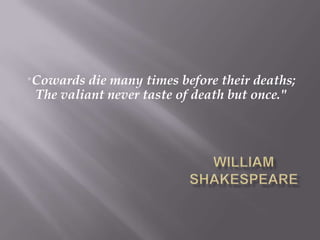William shakespeare
•Télécharger en tant que PPTX, PDF•
1 j'aime•414 vues
coward die many time.....
Signaler
Partager
Signaler
Partager

Recommandé
Recommandé
This presentation was provided by William Mattingly of the Smithsonian Institution, during the third segment of the NISO training series "AI & Prompt Design." Session Three: Beginning Conversations, was held on April 18, 2024.Mattingly "AI & Prompt Design: The Basics of Prompt Design"

Mattingly "AI & Prompt Design: The Basics of Prompt Design"National Information Standards Organization (NISO)
Contenu connexe
Similaire à William shakespeare
Similaire à William shakespeare (6)
Dernier
This presentation was provided by William Mattingly of the Smithsonian Institution, during the third segment of the NISO training series "AI & Prompt Design." Session Three: Beginning Conversations, was held on April 18, 2024.Mattingly "AI & Prompt Design: The Basics of Prompt Design"

Mattingly "AI & Prompt Design: The Basics of Prompt Design"National Information Standards Organization (NISO)
This presentation was provided by William Mattingly of the Smithsonian Institution, during the fourth segment of the NISO training series "AI & Prompt Design." Session Four: Structured Data and Assistants, was held on April 25, 2024.Mattingly "AI & Prompt Design: Structured Data, Assistants, & RAG"

Mattingly "AI & Prompt Design: Structured Data, Assistants, & RAG"National Information Standards Organization (NISO)
APM Welcome
Tuesday 30 April 2024
APM North West Network Conference, Synergies Across Sectors
Presented by:
Professor Adam Boddison OBE, Chief Executive Officer, APM
Conference overview:
https://www.apm.org.uk/community/apm-north-west-branch-conference/
Content description:
APM welcome from CEO
The main conference objective was to promote the Project Management profession with interaction between project practitioners, APM Corporate members, current project management students, academia and all who have an interest in projects.APM Welcome, APM North West Network Conference, Synergies Across Sectors

APM Welcome, APM North West Network Conference, Synergies Across SectorsAssociation for Project Management
Dernier (20)
Mattingly "AI & Prompt Design: The Basics of Prompt Design"

Mattingly "AI & Prompt Design: The Basics of Prompt Design"
Measures of Central Tendency: Mean, Median and Mode

Measures of Central Tendency: Mean, Median and Mode
Web & Social Media Analytics Previous Year Question Paper.pdf

Web & Social Media Analytics Previous Year Question Paper.pdf
9548086042 for call girls in Indira Nagar with room service

9548086042 for call girls in Indira Nagar with room service
Beyond the EU: DORA and NIS 2 Directive's Global Impact

Beyond the EU: DORA and NIS 2 Directive's Global Impact
Mattingly "AI & Prompt Design: Structured Data, Assistants, & RAG"

Mattingly "AI & Prompt Design: Structured Data, Assistants, & RAG"
Measures of Dispersion and Variability: Range, QD, AD and SD

Measures of Dispersion and Variability: Range, QD, AD and SD
APM Welcome, APM North West Network Conference, Synergies Across Sectors

APM Welcome, APM North West Network Conference, Synergies Across Sectors
William shakespeare
- 1. "Cowards die many times before their deaths; The valiant never taste of death but once."
- 2. This quote is from the famous play JULIUS CAESAR written by Shakespeare. It represents courage honor dignity.
- 3. You've already probably figured out that, in this quotation, Shakespeare is drawing a comparison between someone who is a coward (that is, someone who is afraid to face the challenges of life, such as dealing with difficult situations, taking risks, and fighting for what he or she believe in)
- 4. someone who is valiant (that is, someone who is brave in facing the challenges of life, is never afraid to face difficult or risky situations, and will always fight for what he or she believes in).
- 5. When you look at just the first part of the quotation, "Cowards die many times before their deaths," try to think of how someone can actually "die many times" before they actually die. Right away, you realize that Shakespeare is using death as a metaphor (because a person can't physically die multiple times in a single lifetime). Here, he uses the metaphor of death to convey how a person feels inside when he or she runs away from a challenge. That person "dies" a little inside each time he or she chickens out, meaning that he or she loses a little strength of character each time he or she refuses to face a challenge of life.
- 6. Now take the second part of the quotation, "The valiant never taste of death but once." Shakespeare is saying that a valiant person dies only once, which probably means when he or she actually physically dies. So, Shakespeare isn't using death as a metaphor in this part of the quotation. He is saying that a person who is not afraid to face the challenges of life doesn't "die" inside like the coward does. This person can hold their head up high and be proud that he or she faced that difficult situation or fought for what he or she believed in. So, when this brave and valiant person physically dies, this is the only time he or she will know death because he or she has never been afraid to face the challenges of life.
- 7. A coward (however you may define one) is typically a person who runs away from a problem, serious or small. Well every time that person cowers, they sacrifice their dignity or they prove how "unmanly' they are. Most of the time, a coward is continuously a coward and thus, dies (maybe if just a little) each time they fail themselves or others because of their lack of courage or braveness. On the other hand, the brave may fail but they do things with conviction, vigor and righteousness, never losing their honor. They are respected and looked up to by many. They die once (physically) while the cowardly die (metaphorically) a little each time time they chicken out.